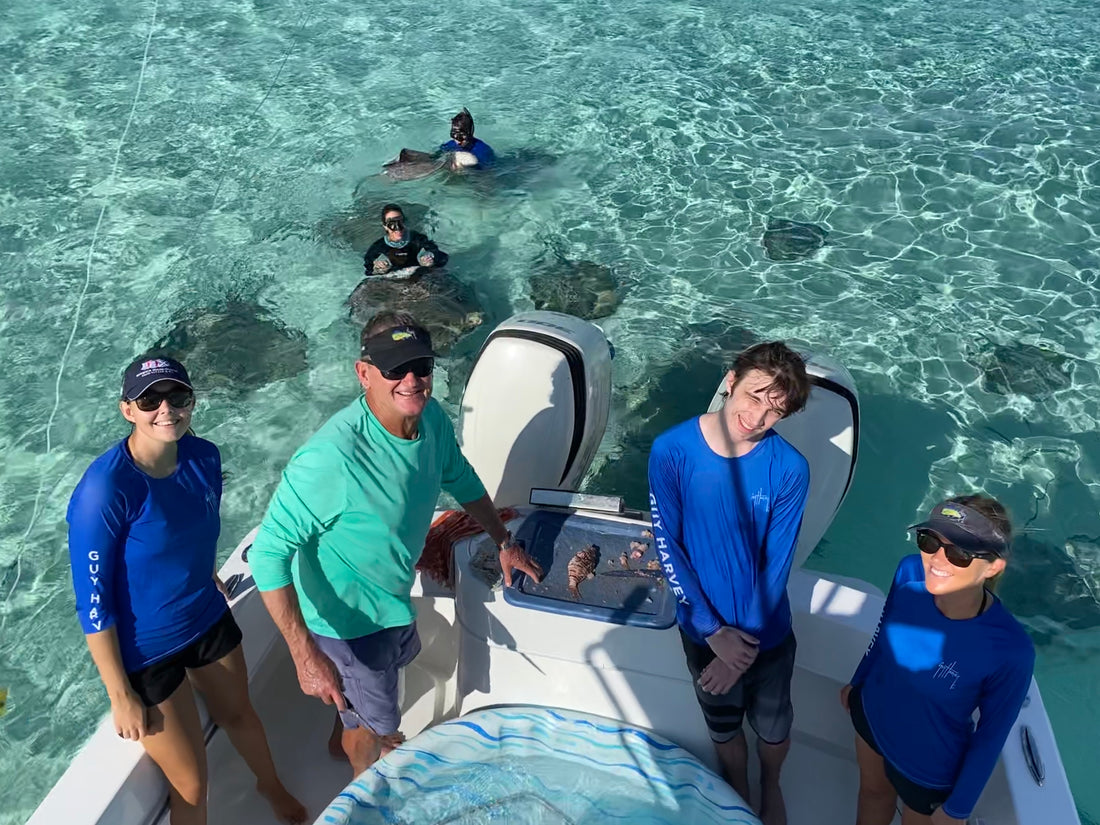As restrictions eased in the Cayman Islands in July, the Guy Harvey Ocean Foundation were able to receive an exemption to conduct their Biannual Southern Stingray Census at Stingray City Sandbar on July 9th -11th, 2020 and processed 60 stingrays (50 females and 10 males) at the site. With an average population of 100 stingrays inhabiting Stingray City Sandbar, the smaller population found was attributed to reduced supplemental feeding during the COVID-19 lock down.
With restrictions on all boating activity in place, the Department of Environment (DoE) and later, the Guy Harvey Ocean Foundation took on the responsibility of feeding and interacting with the rays every day. The DoE began the feeding in early April when the shelter in place restrictions sparked public concern for the stingray’s well-being and fidelity to the tourism site. By the end of May, the DoE had provided 769 lbs. of food and recorded a daily population of between 25 and 30 stingrays.
Between October 10th and 12th, GHOF conducted a follow up survey to assess the population following the complete opening of the North Sound to the public. However, due to the lack of tourism and boating activity, supplemental feeding of the stingrays is still very much reduced with weekends seeing slightly increased activity by locals.
GHOF processed a total of 47 stingrays (41 females and six males) at the Stingray City Sandbar over the three day exhaustive survey. The team also included Deep Stingray City and Rum Point in the survey where they processed three stingrays (two females and one male) at Deep Stingray City and one (female) at Rum Point. Over the three sites, five additional stingrays were seen but were unable to be caught but this is typical of most exhaustive censuses carried out.
All stingrays processed were considered to be in good health condition with no injuries observed, aside from one stingray processed at Rum Point which had a small fishing hook in its mouth. GHOF were unable to remove the hook as it was too deep, but the female ray was able to feed normally. Although this does not confirm that illegal fishing activity is taking place within the Wildlife Interactive Zone (WIZ), we would like to take this opportunity to remind the public that the WIZ is a protected area and the removal of any wildlife at all is prohibited. Elasmobranchs, including stingrays and sharks are also completed protected in the Cayman Islands EEZ under the National Conservation Law.
Although the number of processed stingrays at the Stingray City Sandbar is significantly lower than pre-COVID surveys, research conducted by Guy Harvey Research Institute has shown that these rays do in fact forage naturally in addition to being supplemented at the Sandbar. GHOF is confident that the reduced amount of food being provided on a daily basis is not sufficient enough to sustain a healthy population of 100 rays, however is sufficient enough to sustain a healthy population of 45-50 stingrays. Therefore, it may be likely that the “usual” Stingray City Sandbar population alternately and randomly visits the site as the remainder of the population lives and forages naturally in the North Sound and surrounding areas. It is also likely that the population will increase as feeding and boat traffic to the site also increases.
The Biannual Southern Stingray Census will take place as usually scheduled in January 2021.



1 comment
I support you because you do honest and very important work. Thank you